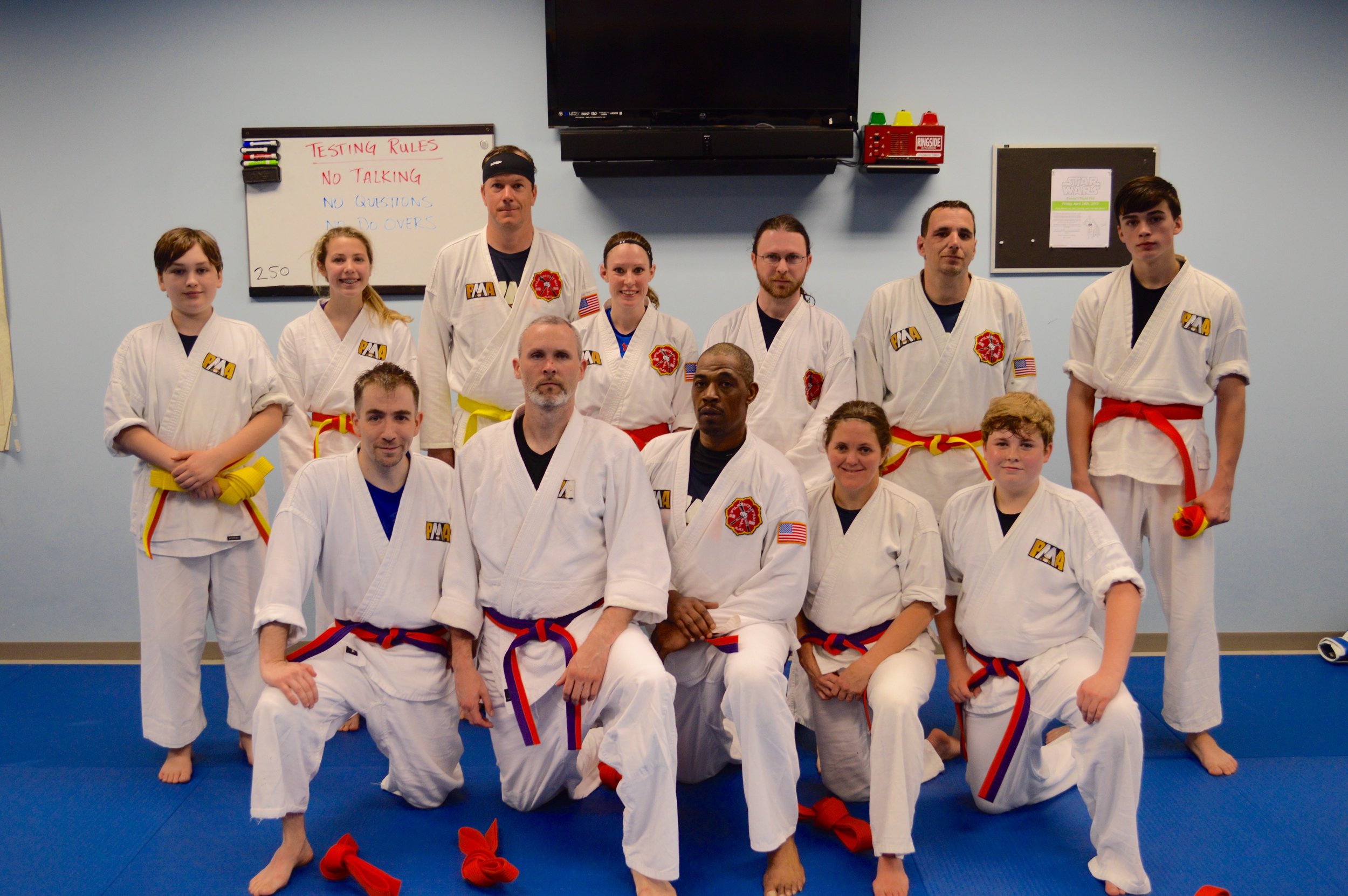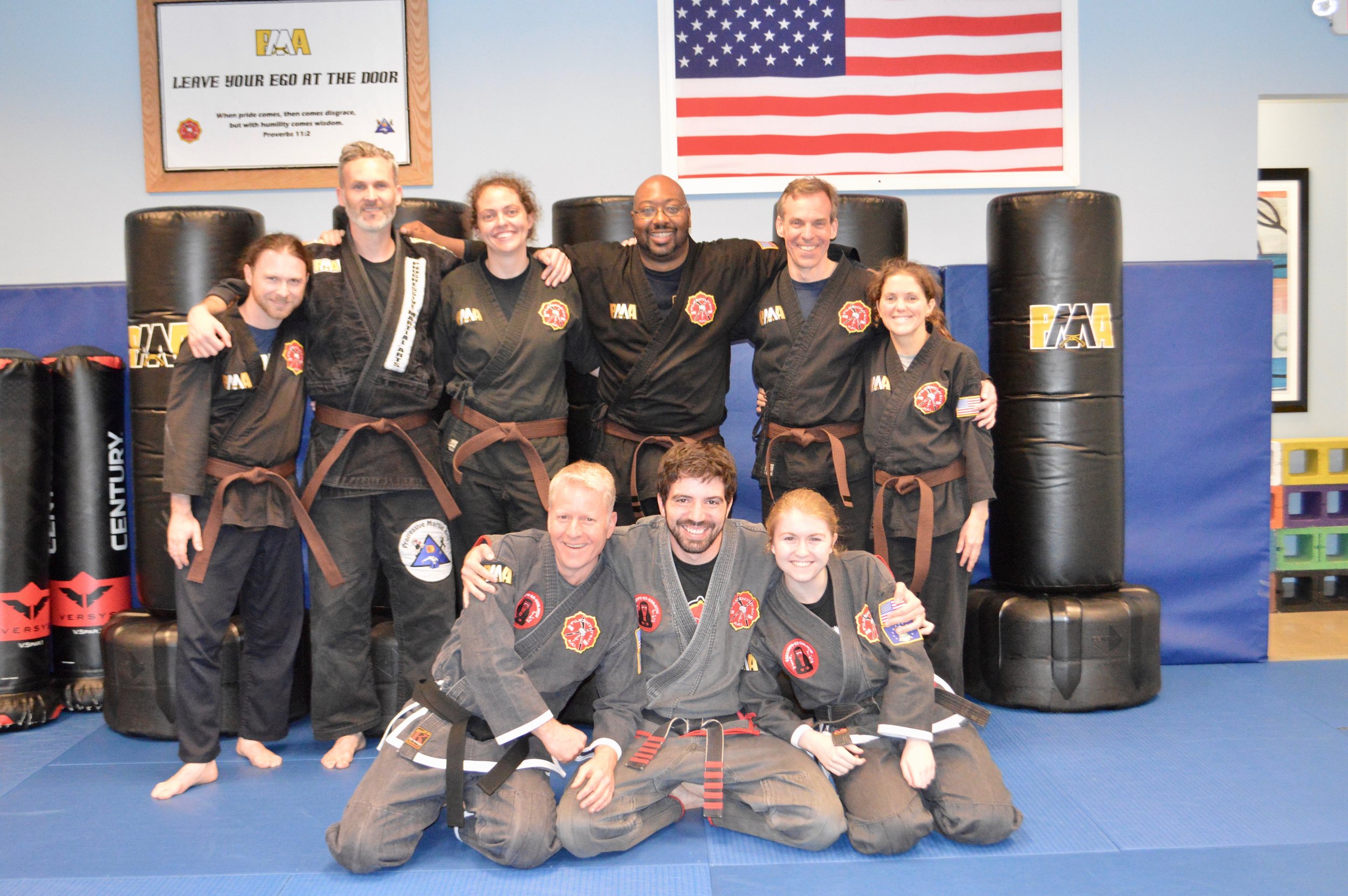*On September 13-15, 5 PMA students tested for and earned their Black Belts in FILKENJUTSU Kenpo. Follow along over the next few weeks, as we share some blog posts that were written by PMA’s newest Black Belts during their preparation for Black Belt. Today’s post is from Isaac Elliott. Isaac is 38 years old and has been training at PMA for almost 5 years.
There are many reasons that people train in the martial arts. Most people think about the fitness aspect, the ability to defend oneself, the confidence that training builds, the community of training partners, or the discipline gained through regular training. One thing that most people wouldn’t normally consider are the long term cognitive benefits training in the martial arts can offer.
While there is limited research on the subject, the understanding is growing. One thing is becoming clear: nearly everyone can benefit from the complex form of exercise that is found in activities like martial arts once they understand what is impacted, what is involved in the training, and why it all works.
Isaac as a beginner student (back row, 5th from left) with some of his classmates!
The impact
There are 2 things that need to be understood in order to see why activities like Martial arts are so beneficial. The first is “Executive Function”, and the second is “Transfer Effect”.
Executive functions (EFs) consist of a family of three, interrelated core skills (inhibitory control, working memory, and cognitive flexibility. Inhibitory control thus makes it possible for us to choose how we react and to change how we behave rather than being “unthinking” creatures of habit or impulse. Working Memory is used to hold information while performing one or more mental operations. It is key for exploring relationships between bits of information, and understanding the relation between a later effect, and an earlier cause. Cognitive Flexibility refers to the ability to flexibly adjust to changed demands or priorities, to look at the same thing in different ways or from different perspectives. This is commonly referred to as “thinking outside the box”. (A. Diamond et al., 2016)
Transfer effect is the change in cognitive performance after training. The area where this effect is most seen is in the Working Memory category. In the Study done by D. Moreau, improvements were seen in working memory, not directly related to the physical activity. The study used an activity similar to wrestling that was called “designed sport”. (D. Moreau et al, 2015). The elements of Moreau’s designed sport focused on introducing perceptive problems, complex motor problems, and cognitive problems. (D. Moreau et al, 2015). An interesting point is found when comparing the effects of normal aerobic exercise to the complex movements of the designed sport. For most tasks the designed sport group showed equivalent or better results than those who did task specific training, while those who did only the simple aerobic exercise showed minimal improvement. (D. Moreau et al, 2015)
Isaac with his partners after a fun night of training!
The training
So, what is in martial arts that makes the difference? There are many branches of martial arts, each developed to address different aspects of fighting. Each has its strengths and weaknesses, and they can be combined synergistically, or used independently. The elements of Moreau’s designed sport focused on introducing perceptive problems, complex motor problems, and cognitive problems. (D. Moreau et al, 2015).
In the interest of full disclosure, the descriptions bellow are drawn from my own training in FILKENJUTSU-KAI. The three styles below are part of the curriculum, and in my opinion best showcase the elements highlighted by the research.
Kenpo karate is primarily a “stand-up” form, and uses scripted techniques to teach fighting concepts. These range from simple sequences consisting of only an evasion, and one or two strikes, up to complex forms with dozens of movements. Kenpo really shines when an opponent is just close enough to land a punch or kick. At the beginner level the movements themselves are complex enough to tax a student’s brain. As the movements become more familiar, more complexity is added. After that the meaning and purpose of each motion is introduced. From a cognitive perspective, this constantly provides opportunity for growth, and if practices correctly, will never fall into that category of “simple” aerobic exercise. As the training progresses, sparing is introduced. This adds a more creative and real word aspect to the training, which enhances the effects further. (A. Diamond et al., 2016)
Brazilian Jujitsu (BJJ) takes a completely different approach, and focuses on the close-range aspect of a fight. This includes grappling on the feet, but the focus is control of the opponent once the fight goes to the ground. The level of complexity in the movement grows quickly due to how many motions per minute of practice can be done. During a 3 minute BJJ “roll” it would not be surprising to count hundreds of techniques, or attempted techniques. Each movement invites a counter, provides an opportunity to escape, or an opening attack. This provides a very complex set of motor and cognitive problems for each person, that must be processed using the student’s knowledge of their own techniques, as well as what is known about their training partner’s level of skill, and knowledge of technique.
Kali is the Filipino art of fighting focused on the use of weapons, as well as the open hand. Much like Kenpo, the striking patterns range from simple to complex. One of the special things about kali is the ability to string the movements together into sequences that can be repeated very quickly. This takes time and practice, but much like BJJ skill can be built quickly because of the rate of repetition. Another element of Kali is the separation of the hands and feet. When first learning the movements, the student is stationary, focusing solely on the hand movement. Then a basic foot pattern is incorporated, keeping rhythm with the hand movements. Then finally the hands and feet are decoupled. The student needs to keep up the hand motions to intercept the partner’s movements. Both students move the feet independently of the hand rhythm to maintain relative position and distance from each other.
Isaac at the end of his brown belt test in FILKENJUTSU Kenpo!
Why it works
All three of these styles start simply, with a strong structure. As the student progresses, so does the complexity and creativity. Ultimately the goal is to integrate all the different styles seamlessly into one fighting art. From a cognition perspective, this incorporates solving perceptive problems, motor problems and genitive problems, but at a higher level that the designed sport used by Moreau. At an advanced level, a student must recognize, process and react to situations with considerable speed, often in a setting where fatigue and mental strain have been introduced. While this directly prepares a student for a physical confrontation where they may need to defend themselves, it also provides mental exercise that transfers to other facets of life.
“To see widespread benefits, diverse skills must be practiced. For that reason, real world activities such as martial arts and certain school curricula (that train diverse executive-function abilities) have shown more widespread cognitive benefits than targeted computerized training” (A. Diamond et al., 2016)
Aerobic exercise itself has been shown to be cognitively beneficial across all age groups and developmental stages. While the effects differ between age groups, improvements to Working Memory are noted everywhere. The data is suggestive of further effects to selective attention and inhibitory control, but more research would be needed to confirm the relationship. (Guiney-Machado, 2013) The benefits to working memory are notable, but not as significant as when the exercise is more complex. (D. Moreau et al, 2015) (A. Diamond et al., 2016)
Isaac earned his Black Belt in September alongside 4 other PMA students - the largest group of Black Belts to test together!
Conclusion
Most of the studies referenced here were conducted over time spans of weeks, or months. From my personal experience I know that the level of movement complexity a person can attain in martial arts in general bounded only by the amount of time spent practicing (barring a physical/neurological limitation). Anecdotally, there have been cases where persons with physical challenges or developmental delays have used elements of martial arts as unofficial therapy, to good effect. I hear stories of children with behavioral and social issues making significant improvements after training for just a few months. It is my strong belief that quality training using complex movement greatly benefits a person’s mental functions.
So, why train in the Martial arts? The ability to defend oneself still floats to the top. The confidence in this ability shows through, and in itself is often a deterrent to attack. Physical fitness is still a major part of training. The sense of community that can be found when training with several like-minded people can be very strong, forming bonds that last a lifetime. But on top of all that now the research is starting to show what practitioner have been claiming for a long time: Training in the martial arts will keep you going mentally as well. Not only maintaining cognitive function, but actually increasing it in a useful and meaningful way.
Isaac and his SiFu, David Corrigan, last Christmas!
References
Adele Diamond, Daphne S. Ling, 2016. Conclusions about interventions, programs, and approaches for improving executive functions that appear justified and those that, despite much hype, do not. Developmental Cognitive Neuroscience 18 (2016) 34–48
David Moreau, Alexandra B. Morrison , Andrew R.A. Conway 2015. An ecological approach to cognitive enhancement: Complex motor training. Acta Psychologica 157 (2015) 44–55
Hayley Guiney & Liana Machado 2013. Benefits of regular aerobic exercise for executive functioning in healthy populations. Psychon Bull Rev (2013) 20:73–86






